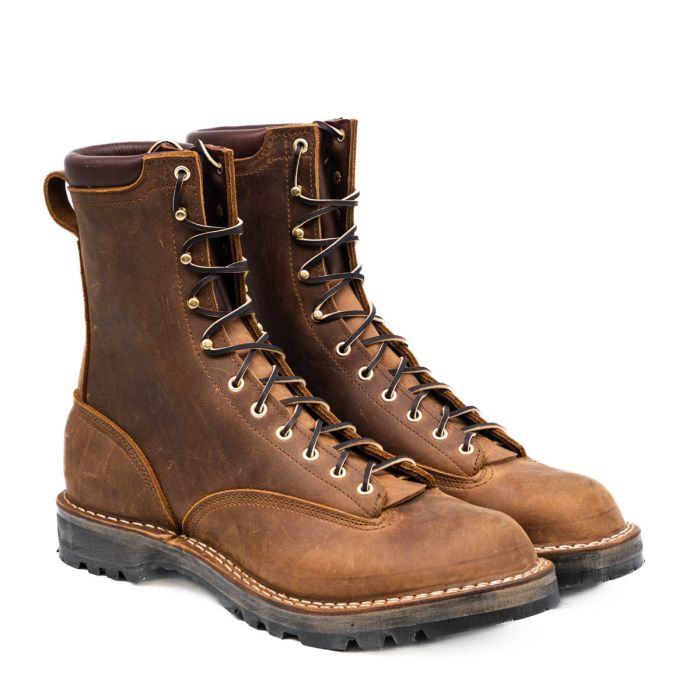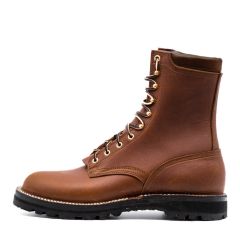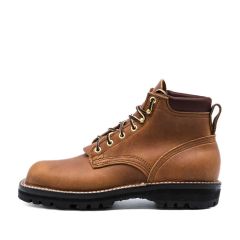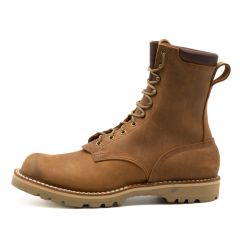Boots For Hunting
Exploring The Essentials Of Hunting Boots
Material Matters
When selecting hunting boots, the choice between durable leather and lightweight synthetic materials is crucial. Leather offers unparalleled durability and natural water resistance, aging well over time, while synthetics provide modern advancements in weight reduction and breathability. Consider the type of hunting and the terrain to make the best choice for your needs, balancing the trade-offs between toughness and lightness.
Waterproofing
Choosing boots equipped with waterproof membranes is essential for keeping your feet dry, regardless of the weather or terrain. These membranes work by allowing moisture from sweat to escape while preventing water from entering the boot. This feature is invaluable in wet conditions, ensuring that your feet stay dry and comfortable throughout your hunt.
Insulation Essentials
Insulation is key when hunting in cold weather, so consider the level of insulation based on the expected conditions. Boots with adequate insulation keep your feet warm in freezing temperatures, but too much can lead to overheating in milder weather. Look for boots with removable or adjustable insulation options to adapt to varying climates and activity levels.
Right Fit
A good fit is non-negotiable to avoid blisters and foot fatigue during long hunts. Ensure there's enough room to wiggle your toes while also securing your heel and midfoot to prevent sliding inside the boot. Properly fitting boots enhance comfort and reduce the risk of injuries, making your hunting experience more enjoyable.
Traction And Support
Good traction and ankle support are essential for navigating rough terrains safely. Boots with deep, aggressive tread patterns offer better grip on slippery or uneven surfaces, while strong ankle support prevents twists and sprains. Prioritize these features to maintain stability and protect yourself against common outdoor injuries.
Breathability
Opting for boots with breathability is crucial, especially in warmer climates or during strenuous hunts. Breathable materials allow sweat to evaporate, keeping your feet cooler and reducing the risk of moisture-related issues. This feature, combined with waterproofing, offers a balance of comfort and protection, keeping your feet dry from both external water and internal perspiration.
The Value Of Waterproof Hunting Boots
- Comfort And Longevity: Wet feet lead to blisters and infections, cutting your hunting trip short. Waterproof boots keep your feet dry, enhancing comfort and allowing you to stay in the field longer.
- Protection From Cold: In cold environments, wet feet can lead to heat loss and hypothermia. Waterproof boots act as a barrier against the cold, keeping your feet warm and reducing the risk of cold-related conditions.
- Versatility: Designed to handle water, mud, snow, and damp vegetation, waterproof boots are versatile across various terrains. You can cross streams or walk through dew-covered fields without enduring wet feet.
- Innovative Technology: Modern waterproof boots allow moisture to escape while keeping water out. Materials can provide a waterproof barrier and allow sweat to evaporate, keeping your feet dry and comfortable.

Insulation Needs For Different Climates
When choosing Nicks Boots hunting boots, it's important to consider the insulation needed for different climates. Here's a breakdown to help you match insulation levels to your hunting environment:
- Mild Climates: Opt for boots with minimal to no insulation (0-200 grams) for areas where temperatures remain above freezing or for early fall hunts.
- Moderate Climates: Choose boots with moderate insulation (400-800 grams) for climates with varying temperatures, especially during late fall hunts.
- Cold Climates: For winter conditions or snowy regions, go for boots with high insulation (1000-2000 grams) to keep your feet warm and comfortable.
Extreme Cold: In sub-zero temperatures, opt for boots with very high insulation (over 2000 grams) to ensure maximum warmth and protection.
The Importance Of Proper Support And Fit
Preventing Blisters And Injuries
Wearing ill-fitting boots can lead to blisters and various injuries. It's crucial to choose boots that offer proper support to minimize the risk of ankle strains and twists. Adequate support ensures that your feet are securely held in place, reducing friction and the potential for blisters, while also providing the stability needed to prevent injuries during your outdoor adventures.
Enhancing Mobility And Stamina
A good fit and adequate support in your boots can significantly enhance your mobility and help conserve energy, which is vital when covering vast distances during extended hunts. Well-supported feet allow for more efficient movement, reducing fatigue and enabling you to remain active and focused on the hunt for longer periods without discomfort.
Ensuring Secure Foot Placement
Proper support in your footwear is key to ensuring secure footing, especially on unpredictable terrain. This can prevent slips and falls, safeguarding against injuries and enabling more confident movement through challenging landscapes. Stability in your boots allows for safer navigation across a variety of surfaces, from slippery riverbanks to rocky trails.
Long-Term Comfort And Foot Health
Boots that are well-fitted, like those from Nicks Boots, not only provide immediate comfort but also promote long-term foot health. They help distribute your weight evenly, reducing strain and preventing issues that can arise from prolonged periods of standing or walking. Consistent comfort and support ensure that your feet remain healthy, allowing you to engage in hunting and other outdoor activities without pain or discomfort.
Finding The Right Fit And Support
To find the best fit and support in hunting boots, it's advisable to try them on later in the day when your feet are slightly swollen, closely mimicking their state during actual hunts. Always wear the socks you plan to hunt in to ensure an accurate fit assessment. Additionally, look for boots that offer features like robust ankle support and quality insoles for enhanced comfort. These elements are essential for maintaining foot health and ensuring a successful, enjoyable hunting experience.

Breaking In Your Hunting Boots: Necessary Steps
Before setting out on your next hunting adventure, it's crucial to ensure your boots are properly broken in. New boots, no matter how well-crafted, are often stiff and not yet molded to the unique shape of your feet. Taking the time to break in your boots can prevent blisters and discomfort, enhancing your overall outdoor experience. Here are necessary steps to properly break in your hunting boots:
- Start With Short Sessions: Begin by wearing your new boots around the house for short periods. This allows the boots to start molding to your feet in a relatively low-stakes environment. Gradually increase the time you wear them to include short walks outside. Avoid getting them dirty or damaged in case you need to exchange them.
- Wear The Right Socks: Ensure you wear the socks that you plan to wear while hunting when breaking in your boots. Different socks have varying thicknesses and can significantly alter the fit and feel of the boot. Using your hunting socks from the start will give you the most accurate sense of how the boots will feel in the field.
- Apply Leather Conditioner: If your boots are made of leather, consider using a leather conditioner to soften them. This can reduce the break-in period and make the material more pliable and comfortable against your feet. Follow the manufacturer’s instructions for the application to avoid damaging the boots.
- Implement The Stair Method: Walking up and down stairs can be particularly effective for breaking in new boots. This movement forces the boot to flex more than walking on flat surfaces, helping to soften stiff materials quicker. Be aware of any discomfort or pressure points that may need more attention.
- Use A Boot Stretcher On Tight Spots: If there are specific areas that feel too tight, such as around the width or the toe box, consider using a boot stretcher overnight to gently expand the material. This targeted approach can alleviate tight spots without affecting the overall fit of the boot.
- Moisten The Boots For A Custom Fit: For a more customized fit, some hunters moisten their boots slightly with water and then wear them until they're dry. This process helps the leather or fabric mold closely to the contours of the foot, though it should be done with caution to avoid water damage. Always check the manufacturer’s guidelines before using water or any wet method to break in your boots.
- Take Them On A Test Hike: Once your boots feel more comfortable indoors, take them for a test hike on terrain similar to where you’ll be hunting. Start with a relatively short, easy hike to avoid potential discomfort. Pay attention to how your feet feel during and after the hike to identify any remaining stiff areas that need more breaking in.
Frequently Asked Questions
What are the best types of boots for hunting in cold weather?
For hunting in cold weather, look for boots that come with significant insulation. The boots should also be waterproof and provide a secure, comfortable fit to keep your feet warm and dry through various terrains and temperatures.
How do waterproof hunting boots differ from regular ones?
Waterproof hunting boots are specifically designed with materials and technology to prevent water from entering, keeping your feet dry even in wet conditions. They differ from regular boots by providing enhanced protection and insulation in environments where you're likely to encounter moisture.
What is the ideal boot height for deer hunting?
The ideal boot height for deer hunting is generally between 8 to 10 inches. This height provides sufficient ankle support, protection from brush and debris, and helps prevent water and small stones from getting inside the boot when moving through various terrains.
Can you recommend boots for hunting in mountainous terrain?
For hunting in mountainous terrain, look for boots that offer strong ankle support, aggressive tread patterns for grip, and a sturdy construction to withstand rough, uneven surfaces. Boots designed with a stiff midsole can also provide additional support on uneven terrain.
Are there any lightweight boots suitable for long tracking sessions?
Yes, several manufacturers offer lightweight boots designed for long tracking sessions. These boots usually feature designs that emphasize comfort, breathability, and mobility without sacrificing protection and durability. Look for materials such as nylon or synthetic fabrics that provide weight savings.
How important is insulation in hunting boots?
Insulation is crucial in hunting boots, especially in cold weather conditions. It helps keep your feet warm, ensuring comfort and focus during long waits or treks. The amount of insulation needed will vary based on personal preference and the conditions in which you'll be hunting.
What kind of boot soles are recommended for hunting in muddy areas?
For hunting in muddy areas, boots with deep, wide lug patterns are recommended. These soles provide better traction and mud release, preventing slippage and caking, which can weigh you down and complicate your hunt.
How do I ensure my hunting boots fit properly?
To ensure your hunting boots fit properly, try them on with the socks you intend to wear while hunting. There should be enough room to wiggle your toes, but your heel and midfoot should feel snug and supported. It's also advisable to walk or even climb stairs in them to ensure there's no slipping or discomfort.
How can I maintain and clean my leather hunting boots?
To maintain and clean your leather hunting boots, start by removing dirt and debris with a soft brush or cloth. Then, clean them with a leather cleaner or mild soap and water. Allow them to dry naturally away from direct heat. Finally, apply a leather conditioner to keep the boots supple and water-resistant.
What features should I look for in early-season hunting boots?
For early-season hunting boots, look for features that provide comfort in warmer temperatures such as lightweight construction, breathability, and lower insulation levels. Moisture-wicking materials and ventilated designs can help keep your feet cool and dry during early-season hunts.






